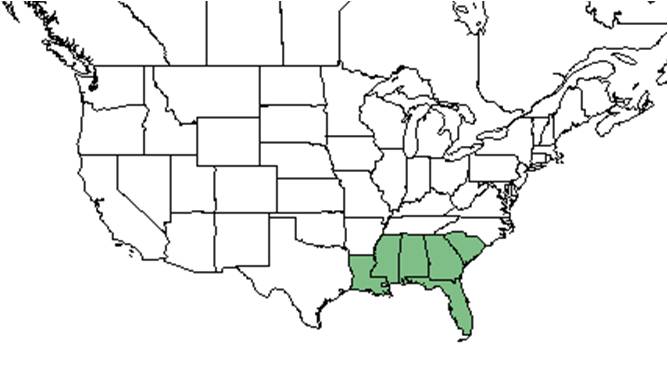Difference between revisions of "Licania michauxii"
KatieMccoy (talk | contribs) (→Distribution) |
KatieMccoy (talk | contribs) |
||
| Line 29: | Line 29: | ||
==Ecology== | ==Ecology== | ||
===Habitat=== <!--Natural communities, human disturbed habitats, topography, hydrology, soils, light, fire regime requirements for removal of competition, etc.--> | ===Habitat=== <!--Natural communities, human disturbed habitats, topography, hydrology, soils, light, fire regime requirements for removal of competition, etc.--> | ||
| − | Habitats of ''L. michauxii'' include pine-palmetto woods; dry pine barrens; sandhills; scrub above wetland depression; shrubby boarders of depression marshes; and wooded slopes of ravines. It has been found in disturbed sites such as cutover flatwoods and dirt roads. Associated species include ''Pinus palustris, Quercus laevis, Aristida stricta, Rhynchosia'' and ''Chrysoma''. Soils include those of Astatula (Typic Quartzipsamments) and Paola (Spodic Quartzipsamments) types (FSU Herbarium). | + | Habitats of ''L. michauxii'' include pine-palmetto woods; dry pine barrens; sandhills; scrub above wetland depression; shrubby boarders of depression marshes; and wooded slopes of ravines. It has been found in disturbed sites such as cutover flatwoods and dirt roads and is a good soil stabalizer <ref name="dave"/>. Associated species include ''Pinus palustris, Quercus laevis, Aristida stricta, Rhynchosia, Bumelia tenax, Juniperus silicicola, Myrica cerifera, Pinus clausa, Quercus geminata, Sabal palmetto'' and ''Chrysoma''. Soils include those of Astatula (Typic Quartzipsamments) and Paola (Spodic Quartzipsamments) types (FSU Herbarium). |
===Phenology=== <!--Timing off flowering, fruiting, seed dispersal, and environmental triggers. Cite PanFlora website if appropriate: http://www.gilnelson.com/PanFlora/ --> | ===Phenology=== <!--Timing off flowering, fruiting, seed dispersal, and environmental triggers. Cite PanFlora website if appropriate: http://www.gilnelson.com/PanFlora/ --> | ||
Revision as of 14:42, 20 January 2016
| Licania michauxii | |
|---|---|

| |
| Photo taken by Gil Nelson | |
| Scientific classification | |
| Kingdom: | Plantae |
| Division: | Magnoliophyta - Flowering plants |
| Class: | Magnoliopsida – Dicotyledons |
| Order: | Rosales |
| Family: | Chrysobalanaceae |
| Genus: | Licania |
| Species: | L. michauxii |
| Binomial name | |
| Licania michauxii Prance | |

| |
| Natural range of Licania michauxii from USDA NRCS Plants Database. | |
Common name: gopher apple
Contents
Taxonomic notes
Description
L. michauxii is a perennial, woody groundcover species, with mature stems only reaching 20 centimeters above the ground (Ward and Taylor 1999). The leathery, long, dark green leaves makes this species resemble an oak seedling[1]. It is often found in thickets on poor, dry, sandy soils[2] and easily spreads by rhizomes that grow 1 to 10 centimeters below the soil (Bell and Taylor 1982, Taylor 1992). The flowers of L. michauxii are small, yellow, and clustered in triangular shaped terminal cymes[3].
Distribution
It is distributed throughout the southeastern U.S., south to Monroe County, Florida. The Monroe County population is disjunct from the Miami-Dade county to the pine rocklands of big pine key [4].
Ecology
Habitat
Habitats of L. michauxii include pine-palmetto woods; dry pine barrens; sandhills; scrub above wetland depression; shrubby boarders of depression marshes; and wooded slopes of ravines. It has been found in disturbed sites such as cutover flatwoods and dirt roads and is a good soil stabalizer [2]. Associated species include Pinus palustris, Quercus laevis, Aristida stricta, Rhynchosia, Bumelia tenax, Juniperus silicicola, Myrica cerifera, Pinus clausa, Quercus geminata, Sabal palmetto and Chrysoma. Soils include those of Astatula (Typic Quartzipsamments) and Paola (Spodic Quartzipsamments) types (FSU Herbarium).
Phenology
Flowers March through June and fruits June through October (FSU Herbarium).
Seed dispersal
Seed bank and germination
Fire ecology
Pollination
The following Hymenoptera families and species were observed visiting flowers of Licania michauxii at Archbold Biological Station (Deyrup 2015):
Apidae: Apis mellifera, Epeolus glabratus, E. zonatus
Colletidae: Colletes sp. A
Halictidae: Agapostemon splendens, Augochlorella aurata, Augochloropsis metallica, A. sumptuosa, Lasioglossum nymphalis, Sphecodes heraclei
Leucospididae: Leucospis robertsoni, L. slossonae
Megachilidae: Megachile brevis pseudobrevis, M. rugifrons
Pompilidae: Anoplius relativus, Paracyphonyx funereus
Sphecidae: Ammophila urnaria, Bembecinus nanus floridanus, Bembix sayi, Bicyrtes quadrifasciata, Cerceris blakei, C. flavofasciata floridensis, C. fumipennis, Microbembex monodonta, Stictiella serrata
Vespidae: Euodynerus castigatus rubrivestris, Pachodynerus erynnis, Parancistrocerus salcularis rufulus, Stenodynerus fundatiformis
Use by animals
Diseases and parasites
Conservation and Management
Cultivation and restoration
Photo Gallery
References and notes
Deyrup, M.A. and N.D. 2015. Database of observations of Hymenoptera visitations to flowers of plants on Archbold Biological Station, Florida, USA.